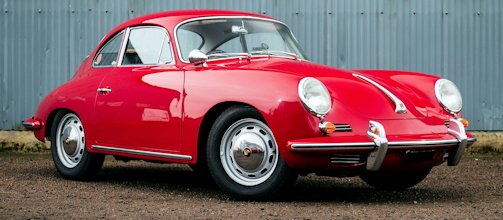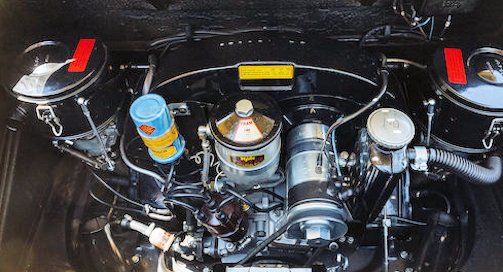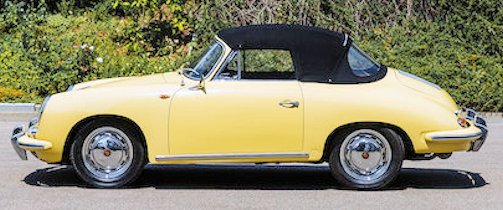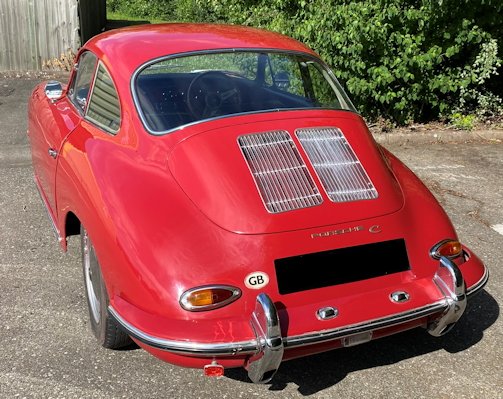Porsche 356 C
 |
|
|
Manufacturer |
Porsche |
|
Production |
1963 to 1965 |
|
Class |
Sports car |
|
Body style |
2-door coupe 2-door convertible |
|
Layout |
RR layout |
|
Engine |
1.6 L B4, 60-95 PS 1.6 L DOHC-B4, 105-115 PS |
|
Wheelbase |
82.7 in (2,100 mm) |
|
Length |
152.4–157.9 in (3,870–4,010 mm) |
|
Width |
65.4 in (1,660 mm) |
|
Height |
48.0–51.8 in (1,220–1,320 mm) |
|
Curb weight |
1,700–2,296 lb (770–1,041 kg) |
|
Designer |
Erwin Komenda |
The Porsche 356 C is the final version of the 356-model built only from 1963 to 1965.
History
The last revision featured disc brakes all round, as well as an option for the most powerful pushrod engine Porsche had ever produced, the 95 hp (71 kW) "SC." 356 production peaked at 14,151 cars in 1964.The 356 C largely corresponds to the last version of the 356 B. Externally, it differs from its predecessor only in modified perforated disc wheels with new hubcaps (without the Porsche crest), which were made necessary by disc brakes on all four wheels. Along with the production of the 356 C and 356 SC, the Porsche 911 started. In 1965, the Porsche 912 with a 911 body, four-cylinder engine and 90 hp (66 kW) replaced the 356 as the cheapest Porsche.

Engine: 4-cylinder, horizontally opposed, air-cooled, bore 825 mm, stroke 74 mm., capacity 1,582 c.c., 107 b.h.p. (S.A.E.) at 5,800 r.p.m.,
Compression ratio 9.5:1; overhead valves; twin downdraught Solex carburettors with air cooled silencers mechanical fuel pump Bosch coil ignition 6-volt 84-amp.
battery; Bosch dynamo, constant voltage control.
PERFORMANCE: SC
- Engine capacity: 96.53 cu in, 1,582 cu cm
- Fuel consumption: 33.2 m/imp gal, 27.7 m/US gal, 8.5 1 x 100 km
- Max speed: 114.9 mph, 185 km/h
- max power (SAE): 107 hp at 5,800 rpm
- max torque (SAE): 99 1b ft, 13.7kg m at 4,200 rpm
- max number of engine rpm: 6,000
- specific power: 67.6 hp/l
- power-weight ratio: 19.2 lb/hp, 8.7 kg/hp
- acceleration: 0—50 mph (0—80 km/h) 7.2 sec
- max speeds: 32 mph, 51.5 km/h in 1st gear; 57.1 mph, 92 km/hin 2nd gear; 88.2 mph, 142 km/h in 3rd gear; 114.9 mph, 185 km/h in 4th gear
Fitted with single dry plate clutch; 4 forward and reverse; all-synchromesh ratios floor-mounted gear change.The chassis and body are an integral welded unit of great stiffness and rigidity; the longitudinal welded box. Section members are cross-braced at front and rear
Ross steering; suspension: front, independent by twin transverse torsion bars of laminated type stabiliser bar, double acting hydraulic telescopic shocks are mounted in a vertical position at front and rear; at the rear a very stiff welded structure carries the engine and gearbox.

Standard equipment includes a heating system washer; variable windscreen wipers; adjustment for seat cigarette lighter; comprehensive range of dash clocks with revolution oil temperature gauge and fuel gauge.
From the outside, the Porsche 356 C can hardly be distinguished from the 356 B T6. The modified wheels with simpler hubcaps, initially without the Porsche crest, are striking. The change in the wheel discs is due to the fact that Porsche now equipped all production vehicles with disc brakes (Ate brakes under Dunlop license). The rear compensating spring was only supplied as an option. A locking differential was also available as an option.

The choice of engines (including Carrera) was reduced to three, which means that the 60 hp version (also called "lady") was eliminated. The body variants offered were a coupe and cabriolet.
Sports versions of the C model
356 Carrera 2 (coupé and convertible): The Carrera 2 was built almost unchanged with the corresponding C modifications (new: Ate disc brakes, dashboard).
1600 CS For rally or racing use of the 1600 CS, Porsche offered, among other things, a choice of a 70- or 90-Liter tank, intake funnel instead of an air filter, roll bar, underbody protection for the engine and transmission, Plexiglas rear window, bucket seats, 15-inch wheels made of light metal and a compensating spring on the rear axle. Crankcase, cylinder and cylinder head are made of light metal.
Production of the 356 series ended in April 1965; 76,302 cars in total were built.

Technical
-
Porsche 356 C Technical details and specifications (1963-1965)
ENGINE
Engine location: rear
4 stroke; cylinders: 4, horizontally opposed
bore and stroke: 3.25 x 2.91 in, 82.5 x 74 mm
engine capacity: 96.53 cu in, 1,582 cu cm
compression ratio: 9, C Coupé 8.5
cylinder block: light alloy, separate cylinders with Ferral chromium interiors
cylinder head: light alloy
crankshaft bearings: 3
valves: 2 per cylinder, Vee-slanted,push-rods and rockers
camshafts: 1, central, lower
lubrication: gear pump,filter on by-pass, oil cooler
carburation: 2 Solex 40 Pll-4 downdraught twin barrel carburettors, C Coupé, 2 Zenith 32 NDIX carburettors
fuel feed: mechanical pump
cooling system: air-cooled.TRANSMISSION
driving wheels: rear
clutch: single dry plate
gearbox: mechanical; gears: 4 + reverse
synchromesh gears: II,, III, IV
gearbox ratios: I 3.090, II 1.765, III 1.130, IV 0.852, rev 3.560
gear lever: central
final drive: spiral bevel
axle ratio: 4.428.CHASSIS
semi-integralSUSPENSION:
front suspension: independent, twin swinging longitudinal trailing arms, transverse laminated torsion bars, anti-roll bar, telescopic dampers
rear suspension: Porsche rear suspension independent, swinging semi-axles, swinging longitudinal trailing arms, transverse torsion bars, transverse compensating leafspring (single leaf), telescopic dampers.STEERING
cam and peg, damper
turns of steering wheel lock to lock: 2.50.
turning circle (between walls): 36.1 ft, 11 mBRAKES
disc (front diameter 8.94 in, 227 mm, rear 9.57 in, 243 mm).ELECTRICAL EQUIPMENT
voltage: 6 V
battery: 84 Ah
dynamo: 200 W
ignition distributor: BoschDIMENSIONS AND WEIGHT
wheel base: 82.68 in, 2,100 mm
front track: 51.42 in 1,306 mm
rear track: 50.08 in, 1,272 mm
overall length: 157.87 in, 4,010 mm
overall width: 65.75 in, 1,670 mm
overall height: 51.77 in, 1,315 mm
ground clearance: 5.90 in, 150 mm
dry weight: 2,062 1b, 935 kg
distribution of weight: 44% front axle, 56% rear axleOPTIONAL
sunshine roof
leather upholstery
limited slip final drive
300 W dynamo
4-speed mechanical gearbox and overdrive/top (I 3.900, II 1.935, III 1.350, IV 1.130
overdrive/top 1.040, rev 3.560 or1 3.090, Il 1.935, Ill 1.350, IV 1.040, rev 3.560)Specifications - C and SC
Porsche 356C:
1600c
1600SC
Engine:
4-cylinder boxer engine (four-stroke)
Displacement:
1582cc
Bore × Stroke:
82.5×74mm
Performance:
75 hp (55 kW)
at 520095 hp (70 kW)
at 5800Max. torque at 1/min:
123 Nm at 3600
124 Nm at 4200
Compression:
8.5:1
9.5:1
valve control:
central camshaft, tappets, pushrods and rocker arms
Cooling:
air cooling (blower)
Transmission:
4-speed gearbox, stick shift
Front suspension:
Crank link axle with stabilizer
Rear suspension:
Pendulum axle with longitudinal thrust struts
Front suspension:
2 continuous leaf spring rods
Rear suspension:
1 round torsion bar on each side
Body:
Box frame made of sheet steel,
body welded to floor assemblyTrack width front/rear:
1306/1272mm
Wheelbase:
2100mm
Tires rim:
5.60 – 15 sports
165 – 15 (belt)
Dimensions L × W × H:
4010×1670×1315mm
curb weight:
935kg
Top speed:
175km/h
185km/h
Porsche 356C history
model
performance
356 1600c
55 kW/75 hp
356 1600SC
70 kW/95 hp
356 Carrera 2
96 kW/130 hp
Production
Year
production
1963
9,672
1964
10,575
1965
1,685
1966
10
© Motor car History
Service
-
Porsche 356 C Service Guide (1963-1965)
Fuel: 95-100 oct petrol
Engine sump oil: 7.04 imp pt, 8.46 US pt, 4 1, SAE 20 (winter) 30 (summer), change every 1,900 miles,3,000 km
Lubricating system total capacity: 8.80 imp pt, 10.57 US pt, 5 1
Gearbox and final drive oil: 6.16 imp pt, 7.40 US pt, 3.5 1, SAE 90, change every 11,200 miles, 18,000 km
Steering box oil: 0.35 imp pt, 0.42 US pt, 0.2 1, SAE 90
Greasing: every 900 miles, 1,500 km, 12 points
Tappet clearances: inlet 0.006 in, 0.15 mm, exhaust 0.004 in, 0.10 mm
Valve timing: inlet opens 17° before tdc and closes 53° after bdc, exhaust opens 50° before bdc and closes 14° after tdc
Tyre pressure (normal load): front 26 psi, 1.8 atm, rear28 psi, 2 atm.
Tyres: 165 x 15, C Coupé,5.60 x 15 tyres
Fuel tank capacity: 11 imp gal, 13.2 US gal
Carrying capacity: 695 1b, 315 kg© Motor car History
